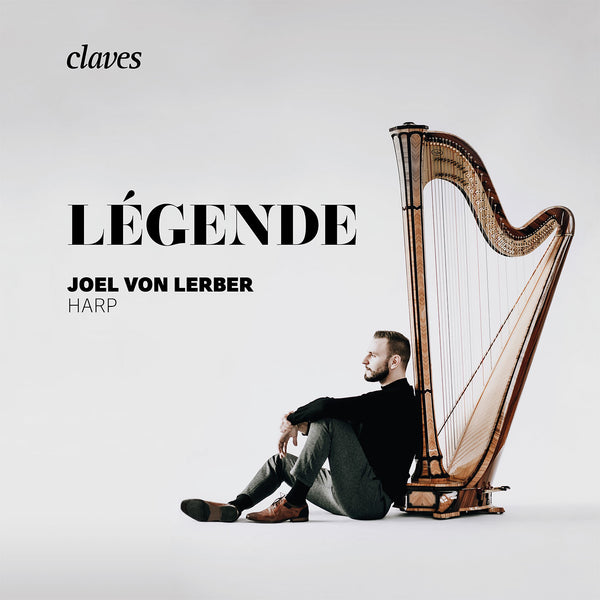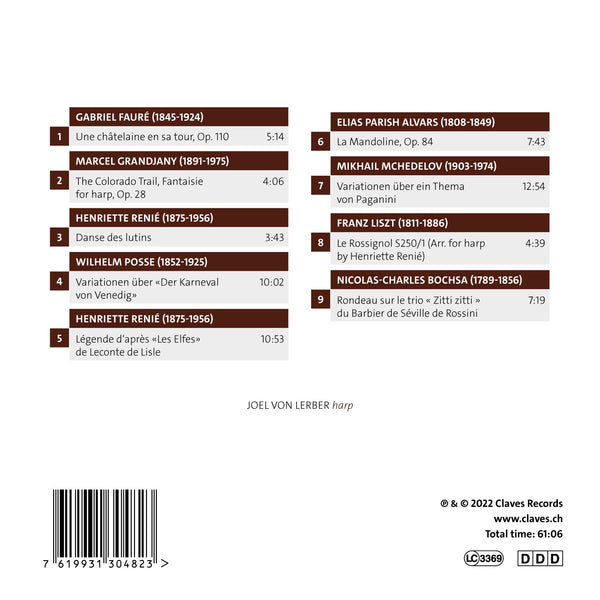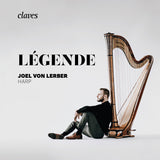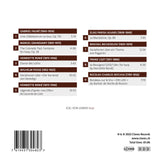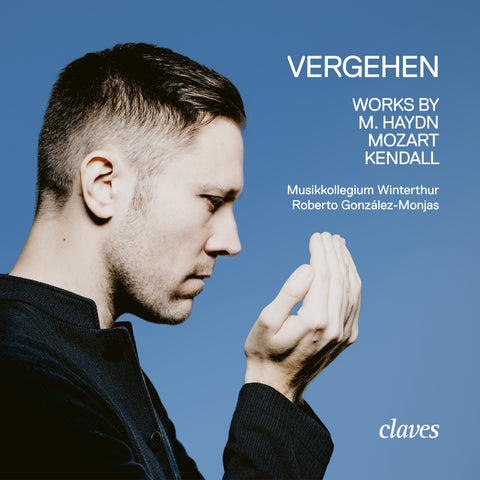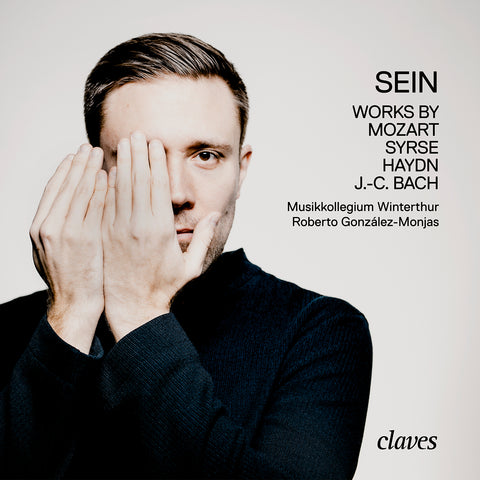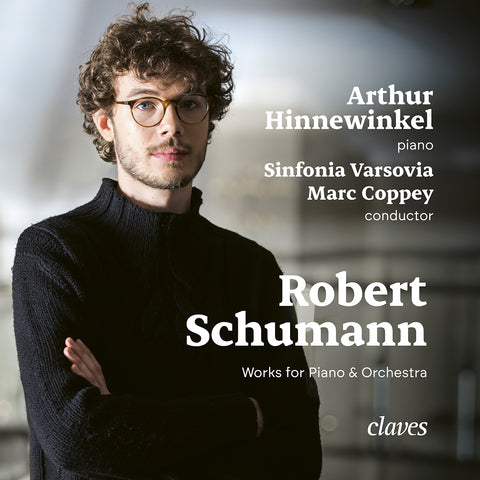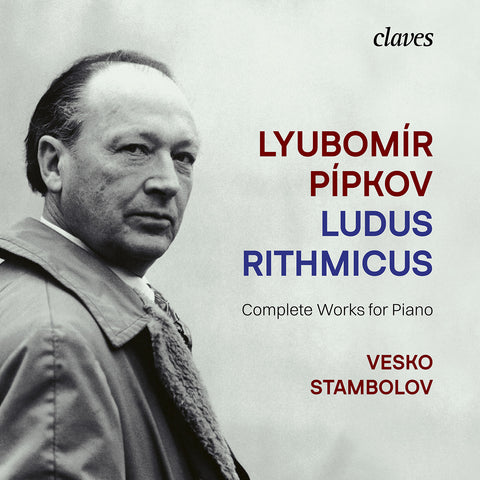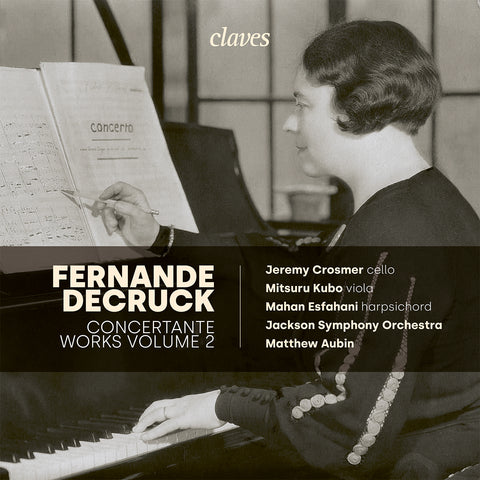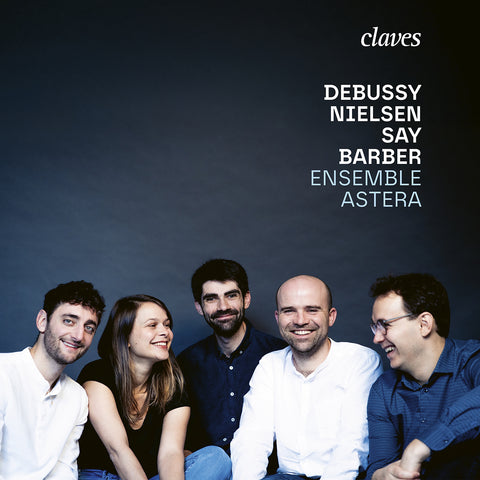(2022) Joel von Lerber: Légende
Category(ies): Chamber Rarities
Instrument(s): Harp
Main Composer: Various composers (see collections)
CD set: 1
Catalog N°:
CD 3048
Release: 27.05.2022
EAN/UPC: 7619931304823
This album is now on repressing. Pre-order it at a special price now.
CHF 18.50
This album is no longer available on CD.
This album has not been released yet. Pre-order it from now.
CHF 18.50
This album is no longer available on CD.
CHF 18.50
VAT included for Switzerland & UE
Free shipping
This album is no longer available on CD.
VAT included for Switzerland & UE
Free shipping
This album is now on repressing. Pre-order it at a special price now.
CHF 18.50
This album is no longer available on CD.
This album has not been released yet.
Pre-order it at a special price now.
CHF 18.50
This album is no longer available on CD.
CHF 18.50
This album is no longer available on CD.
JOEL VON LERBER: LÉGENDE
LÉGENDE
The French instrument maker Sébastien Érard was significantly involved in the modern harp’s development. In 1810, he patented the fully chromatic double-action harp. Thanks to the instrument’s seven pedals and a sophisticated mechanism, it was now possible to change the string lengths and raise each note up to two semitones. This enabled the harpist to play in all keys without retuning the instrument. Composers such as Richard Wagner, Gustav Mahler and Claude Debussy took advantage of these new possibilities and established the harp as an orchestra instrument. In his “Treatise upon Modern Instrumentation and Orchestration” (published in 1844), Hector Berlioz claimed that the harp should never be placed behind the orchestra.
The harp was also brought to the foreground as a solo instrument in classical music repertoire. The French harpist Henriette Renié (1875 – 1956) played a significant part in this popularity. Thanks to her highly virtuoso playing, her own compositions and arrangements of pieces by other composers, she decisively influenced the music for harp solo at the beginning of the 20th century. She also inspired other composers (including Claude Debussy and Maurice Ravel) to write works for the harp and was a much sought-after teacher with many successful pupils. In 1914, she launched the “Concours Renié”, the first international harp competition. In her own works, Henriette Renié often dealt with fantasy topics. Such is the case in the Légende d’après «Les Elfes» de Leconte de Lisle, which she wrote in 1901 after a poem by French author Leconte de Lisle. The text is about a black knight riding at night through the forest in search of his bride. He encounters malevolent elves that try to seduce him. When they fail, they kill the knight’s fiancée. The knight then also dies out of desperation and love. The Légende pointedly begins with the harp’s lowest note, which keeps on reappearing in the following bars like an urgent reminder. An incisive scale in unison follows it. This is the starting point of a partly descriptive musical programme. The horse’s galloping and the elves’ nimble movements are just as perceptible as the eerie atmosphere of the dark forest, the treachery of the elves and the last breathe of life. In the final bars, the low note is heard once again. It now announces the tragic end like a death knell. In her Légende, Henriette Renié greatly expanded the harp’s sound range, masterfully using all the instrument’s possibilities. Her precise performance instructions and the tremendous technical challenges on the performer are striking. Renié’s virtuoso Danse des lutins (Dance of the Goblins, composed in 1911) also takes us into a fantasy world: goblins jump back and forth, do somersaults, suddenly stop and then resume their merry dance. In this piece, the harpist must have both nimble fingers and very agile feet to achieve rapid successive harmonic changes with the pedals. The Danse des lutins is reminiscent of Franz Liszt’s Gnomenreigen (Dance of the Gnomes), a composer who much influenced Henriette Renié. She transcribed some of his piano pieces for the harp, including Le Rossignol (The Nightingale). Franz Liszt wrote this piece after an eponymous song by the Russian composer Alexander Alyabyev. [..]
***
JOEL VON LERBER
Joel von Lerber was born in Basel, Switzerland in 1991. He was only six when he took his first harp lessons at the Bern Conservatory with Nathalie Châtelain and in the following years with Simon Bilger. His Bachelor’s degree (with Sarah O’Brien) was followed by a Master of Arts (Performance) with Sarah O’Brien at the Zurich University of the Arts in 2014. Two years later, he obtained a Master of Music with Prof. Maria Graf at the Hanns Eisler School of Music Berlin. In 2019, he took the “Konzertexamen”, equally with Prof. Maria Graf. The exam concert at the Konzerthaus Berlin, which he passed “with distinction”, was also his debut with the Konzerthausorchester Berlin. Joel von Lerber also received artistic stimulation through masterclasses with reputed artists such as Helga Storck, Isabelle Moretti, Jana Boušková, Xavier de Maistre and pianist Pavlin Nechev. In addition, Joel has benefited from various scholarships, including those of the DAAD (German Academic Exchange Service) and the Migros - Kulturprozent.
Joel is a prize-winner of numerous international competitions, including the International Harp Competition of the Franz Josef Reinl Foundation in Munich (2011, 1st Prize), the International Louis Spohr Competition in Kassel (2013, 1st Prize and Audience Award), the Golden Harp Competition in St. Petersburg (2014, 3rd Prize), the Michal Spisak International Music Competition In Poland (2015, 2nd Prize and Special Prize), the International Harp Competition in Mexico (2017, 2nd Prize) and the renowned International Harp Contest in Israel (2018, 2nd Prize and two special prizes for the best interpretation).
Joel von Lerber regularly performs as a soloist in Switzerland and Germany, with ensembles such as the Bern Chamber Orchestra, the Fribourgeois Chamber Orchester, Kammerphilharmonie Graubünden, the Konzerthausorchester Berlin, the Vorpommern Philharmonic Orchestra and the Filmorchester Babelsberg. He has also performed with the State Hermitage Orchestra in St. Petersburg, the Mexico City Symphony Orchestra in Mexico City, the Filharmonia Zabrzanksa in Poland and the Haifa Symphony Orchestra in Israel, as well as with the Brandenburg State Orchestra.
***
Take a look at our Harp albums
REVIEWS
« Der Schweizer Harfenist Joel von Lerber widmet sich dem virtuosen Repertoire für die moderne Konzertharfe: Am 27. Mai erscheint sein Album „Légende“ mit einem Programm, das Höhepunkte des romantischen Harfen-Repertoires zu einem stimmigen Porträt sowohl des Instrumentes als auch des Künstlers verbindet. [..] Joel von Lerber gehört zweifelsohne zu den jungen, noch zu entdeckenden Harfenisten. Neben ausgezeichneten Studienabschlüssen in Zürich bei Sarah O’Brien und bei Maria Graf in Berlin war er vielfacher Sieger und Preisträger internationaler Wettbewerbe. » - Maria Kühne, April 2022
“Berlin-based harpist Joel von Lerber is releasing his second album, Légende, on May 27 on the Claves Records label. The album will be available on all platforms, including Spotify and Amazon Music, and through Claves Records. We reached out to von Lerber to learn more about his CD.” - Mai 2022
« [..] Noch sinfonischer denkt der Basler Joel von Lerber sein Instrument – in nicht unähnlichem Repertoire zieht er alle Register. Allerdings sind es bei ihm vor Originalkompositionen, etwa von Henriette Renié, Elisas Parish Alvars, Wilhelm Posse und anderen, meist vergessenen Komponisten aus dem 19. Jahrhundert. Und auch hier: Elfen und Nachtigallen verführen in märchenhafte Welten. Musikalische Liebesbriefe verschickt Elisabeth Plank mit der CD «Musings» (Nachdenken). [..] » - Christian Berzins, Juni 2022
“Like a mythical harp-playing bard, Joel von Lerber too is a teller of legends. But such is the Berlin-based Swiss harpist’s sweeping command of colour and line that he has no need for words. The music, almost all of which takes its inspiration from tales or poems, says it all. Von Lerber’s second album and first for Swiss label Claves is also a homage to that great harp virtuoso, composer and pedagogue Henriette Renié. Her darkly dramatic Légende d’après ‘Les elfes’ de Leconte de Lisle, with its echoes of Schubert’s ‘Erlkönig’, and the sprightly Danse des lutins are two of the highlights of the programme, showing off von Lerber’s supple technique and narrative skills to their best advantage. [..]” - William Yeoman, August 2022
« Harp Life has long been listing Emanuel Ceysson, Remy Van Kesteren, and Alexander Bordachev as male harpists in the post-Maistre era, calling them the "Next Generation Triumvirate," and has featured them in our articles. Joel von Lerber is the fourth man, the dark horse, who has been rapidly following in their footsteps. He lives in Berlin, Germany, one of the capitals of music, and plays a beautiful harp music that belies his massive appearance. We spoke with the man who is rumored to have a "gap" in his life. [..] » - January 2023
« Der Schweizer Harfenist Joel von Lerber widmet sich dem virtuosen Repertoire für die moderne Konzertharfe: Am 27. Mai erscheint sein Album „Légende“ mit einem Programm, das Höhepunkte des romantischen Harfen-Repertoires zu einem stimmigen Porträt sowohl des Instrumentes als auch des Künstlers verbindet. [..] » - Mai 2022
“[..] Throughout the disc the playing of the Swiss-born harpist Joel von Lerber is excellent; he draws out the character of each work (especially important in a programme made up of nine works, the longest of them under thirteen minutes long); his technique seems perfect, his touch sensitive and powerful as needed. The acoustic of Church Oberschönweide in Berlin is wholly sympathetic. All lovers of the harp will surely get much pleasure from this disc.” - Glyn Pursglove, April 2024
« [..] Und wer sich die brandneue CD im wahrsten Sinn des Wortes reinzieht, der erlebt Freude pur jenseits von Gezirpe und Gesäusele. Da ist schöne und lebendige und ingelligent zusammengestellte Musik aktiv. » - Wolf Loeckle
“[..] The latter is crystal clear from this new album, on which the Swiss harpist Joel von Lerber excels in a well-chosen, varied program in which the technical possibilities of playing the harp and the idiomatic characteristics of the nine very different and therefore contrasting pieces are shown off to their best advantage. This was already evident, incidentally, with his CD released in December 2019 on the Costa Records label (including on Spotify). [..]” - Aart van der Wal, June 2022
“Swiss harpist Joel von Lerber's new album Légende explores a wealth of repertoire written for the harp, the majority of it by harpists. It also captures a snapshot of a fascinating rivalry between two competing manufacturers, both of whom had devised their own original solution to the instrument's limitations and both of whom wanted their new design to be universally adopted. I spoke to Joel about the music on this album - and ended up diving deep into the history of this most beautiful and charismatic of instruments, and the lengths that the rival instrument-builders went to in pursuit of market dominance! Interview. [..]” - David Smith, August 2022
« Kaum ein Instrument ist derart mit Klischees umstellt wie die Harfe. Joel von Lerber widerlegt sie locker. Den Tücken seines Instruments steht er entspannt gegenüber und vom Harfenklang ist er nach wie vor fasziniert. Er ist einer der wenigen jungen Männer an der Harfe. Joel von Lerber ist in Rüeggisberg bei Bern aufgewachsen, heute lebt er in Berlin. Die Stufen seiner Ausbildung hat er alle mit Auszeichnung gemeistert, und mit 31 Jahren ist seine Karriere als Solist schon beachtlich. Kürzlich hat er, wie er sagt, «erstmals einen Preis bekommen, ohne etwas zu tun», den Premio Rossetti Montano, eine Auszeichnung als international bedeutender Interpret. Interview. [..] » - Pia Schwab, Mai 2023
« Sortie spectaculaire dédiée à la harpe chez Claves, avec cette Légende du harpiste bâlois Joel von Lerber. Le disque tient son titre d’une pièce de la harpiste française Henriette Renié, virtuose, pédagogue et compositrice au rôle pionnier dans la popularisation de l’instrument durant la première moitié du XXe siècle. [..] Légende fait aussi référence à tout un répertoire d’inspiration féerique qui, dans la harpe et sa voix impressionniste, évocatrice, trouve un moyen d’expression privilégié. Les pièces de ce genre présentées ici («Légende» et «Danse des lutins» d’Henriette Renié, «Une châtelaine en sa tour» de Gabriel Fauré, mais aussi le paysage sonore «The Colorado Trail» de Marcel Grandjany) sont magistralement jouées par Joel von Lerber, qui explose la palette de nuances de son instrument. Son jeu est également admirable dans la seconde moitié de cet enregistrement, où il explore le répertoire des autres maîtres, virtuoses légendaires eux aussi, qui ont contribué au prestige de la harpe depuis sa conception moderne par Erard en 1810: Posse, Alvars, Mchedelov, Bochsa. [..] . Joel von Lerber par son jeu spectaculaire, riche en nuances, capable de dialoguer avec le silence dans ses pianissimo et grandiose dans ses forte, accomplit le miracle de lui rendre justice et de nous restituer son agréable capacité à surprendre. » - Gianluigi Bocelli, juillet 2022
(2022) Joel von Lerber: Légende - CD 3048
LÉGENDE
The French instrument maker Sébastien Érard was significantly involved in the modern harp’s development. In 1810, he patented the fully chromatic double-action harp. Thanks to the instrument’s seven pedals and a sophisticated mechanism, it was now possible to change the string lengths and raise each note up to two semitones. This enabled the harpist to play in all keys without retuning the instrument. Composers such as Richard Wagner, Gustav Mahler and Claude Debussy took advantage of these new possibilities and established the harp as an orchestra instrument. In his “Treatise upon Modern Instrumentation and Orchestration” (published in 1844), Hector Berlioz claimed that the harp should never be placed behind the orchestra.
The harp was also brought to the foreground as a solo instrument in classical music repertoire. The French harpist Henriette Renié (1875 – 1956) played a significant part in this popularity. Thanks to her highly virtuoso playing, her own compositions and arrangements of pieces by other composers, she decisively influenced the music for harp solo at the beginning of the 20th century. She also inspired other composers (including Claude Debussy and Maurice Ravel) to write works for the harp and was a much sought-after teacher with many successful pupils. In 1914, she launched the “Concours Renié”, the first international harp competition. In her own works, Henriette Renié often dealt with fantasy topics. Such is the case in the Légende d’après «Les Elfes» de Leconte de Lisle, which she wrote in 1901 after a poem by French author Leconte de Lisle. The text is about a black knight riding at night through the forest in search of his bride. He encounters malevolent elves that try to seduce him. When they fail, they kill the knight’s fiancée. The knight then also dies out of desperation and love. The Légende pointedly begins with the harp’s lowest note, which keeps on reappearing in the following bars like an urgent reminder. An incisive scale in unison follows it. This is the starting point of a partly descriptive musical programme. The horse’s galloping and the elves’ nimble movements are just as perceptible as the eerie atmosphere of the dark forest, the treachery of the elves and the last breathe of life. In the final bars, the low note is heard once again. It now announces the tragic end like a death knell. In her Légende, Henriette Renié greatly expanded the harp’s sound range, masterfully using all the instrument’s possibilities. Her precise performance instructions and the tremendous technical challenges on the performer are striking. Renié’s virtuoso Danse des lutins (Dance of the Goblins, composed in 1911) also takes us into a fantasy world: goblins jump back and forth, do somersaults, suddenly stop and then resume their merry dance. In this piece, the harpist must have both nimble fingers and very agile feet to achieve rapid successive harmonic changes with the pedals. The Danse des lutins is reminiscent of Franz Liszt’s Gnomenreigen (Dance of the Gnomes), a composer who much influenced Henriette Renié. She transcribed some of his piano pieces for the harp, including Le Rossignol (The Nightingale). Franz Liszt wrote this piece after an eponymous song by the Russian composer Alexander Alyabyev. [..]
***
JOEL VON LERBER
Joel von Lerber was born in Basel, Switzerland in 1991. He was only six when he took his first harp lessons at the Bern Conservatory with Nathalie Châtelain and in the following years with Simon Bilger. His Bachelor’s degree (with Sarah O’Brien) was followed by a Master of Arts (Performance) with Sarah O’Brien at the Zurich University of the Arts in 2014. Two years later, he obtained a Master of Music with Prof. Maria Graf at the Hanns Eisler School of Music Berlin. In 2019, he took the “Konzertexamen”, equally with Prof. Maria Graf. The exam concert at the Konzerthaus Berlin, which he passed “with distinction”, was also his debut with the Konzerthausorchester Berlin. Joel von Lerber also received artistic stimulation through masterclasses with reputed artists such as Helga Storck, Isabelle Moretti, Jana Boušková, Xavier de Maistre and pianist Pavlin Nechev. In addition, Joel has benefited from various scholarships, including those of the DAAD (German Academic Exchange Service) and the Migros - Kulturprozent.
Joel is a prize-winner of numerous international competitions, including the International Harp Competition of the Franz Josef Reinl Foundation in Munich (2011, 1st Prize), the International Louis Spohr Competition in Kassel (2013, 1st Prize and Audience Award), the Golden Harp Competition in St. Petersburg (2014, 3rd Prize), the Michal Spisak International Music Competition In Poland (2015, 2nd Prize and Special Prize), the International Harp Competition in Mexico (2017, 2nd Prize) and the renowned International Harp Contest in Israel (2018, 2nd Prize and two special prizes for the best interpretation).
Joel von Lerber regularly performs as a soloist in Switzerland and Germany, with ensembles such as the Bern Chamber Orchestra, the Fribourgeois Chamber Orchester, Kammerphilharmonie Graubünden, the Konzerthausorchester Berlin, the Vorpommern Philharmonic Orchestra and the Filmorchester Babelsberg. He has also performed with the State Hermitage Orchestra in St. Petersburg, the Mexico City Symphony Orchestra in Mexico City, the Filharmonia Zabrzanksa in Poland and the Haifa Symphony Orchestra in Israel, as well as with the Brandenburg State Orchestra.
***
Take a look at our Harp albums
REVIEWS
« Der Schweizer Harfenist Joel von Lerber widmet sich dem virtuosen Repertoire für die moderne Konzertharfe: Am 27. Mai erscheint sein Album „Légende“ mit einem Programm, das Höhepunkte des romantischen Harfen-Repertoires zu einem stimmigen Porträt sowohl des Instrumentes als auch des Künstlers verbindet. [..] Joel von Lerber gehört zweifelsohne zu den jungen, noch zu entdeckenden Harfenisten. Neben ausgezeichneten Studienabschlüssen in Zürich bei Sarah O’Brien und bei Maria Graf in Berlin war er vielfacher Sieger und Preisträger internationaler Wettbewerbe. » - Maria Kühne, April 2022
“Berlin-based harpist Joel von Lerber is releasing his second album, Légende, on May 27 on the Claves Records label. The album will be available on all platforms, including Spotify and Amazon Music, and through Claves Records. We reached out to von Lerber to learn more about his CD.” - Mai 2022
« [..] Noch sinfonischer denkt der Basler Joel von Lerber sein Instrument – in nicht unähnlichem Repertoire zieht er alle Register. Allerdings sind es bei ihm vor Originalkompositionen, etwa von Henriette Renié, Elisas Parish Alvars, Wilhelm Posse und anderen, meist vergessenen Komponisten aus dem 19. Jahrhundert. Und auch hier: Elfen und Nachtigallen verführen in märchenhafte Welten. Musikalische Liebesbriefe verschickt Elisabeth Plank mit der CD «Musings» (Nachdenken). [..] » - Christian Berzins, Juni 2022
“Like a mythical harp-playing bard, Joel von Lerber too is a teller of legends. But such is the Berlin-based Swiss harpist’s sweeping command of colour and line that he has no need for words. The music, almost all of which takes its inspiration from tales or poems, says it all. Von Lerber’s second album and first for Swiss label Claves is also a homage to that great harp virtuoso, composer and pedagogue Henriette Renié. Her darkly dramatic Légende d’après ‘Les elfes’ de Leconte de Lisle, with its echoes of Schubert’s ‘Erlkönig’, and the sprightly Danse des lutins are two of the highlights of the programme, showing off von Lerber’s supple technique and narrative skills to their best advantage. [..]” - William Yeoman, August 2022
« Harp Life has long been listing Emanuel Ceysson, Remy Van Kesteren, and Alexander Bordachev as male harpists in the post-Maistre era, calling them the "Next Generation Triumvirate," and has featured them in our articles. Joel von Lerber is the fourth man, the dark horse, who has been rapidly following in their footsteps. He lives in Berlin, Germany, one of the capitals of music, and plays a beautiful harp music that belies his massive appearance. We spoke with the man who is rumored to have a "gap" in his life. [..] » - January 2023
« Der Schweizer Harfenist Joel von Lerber widmet sich dem virtuosen Repertoire für die moderne Konzertharfe: Am 27. Mai erscheint sein Album „Légende“ mit einem Programm, das Höhepunkte des romantischen Harfen-Repertoires zu einem stimmigen Porträt sowohl des Instrumentes als auch des Künstlers verbindet. [..] » - Mai 2022
“[..] Throughout the disc the playing of the Swiss-born harpist Joel von Lerber is excellent; he draws out the character of each work (especially important in a programme made up of nine works, the longest of them under thirteen minutes long); his technique seems perfect, his touch sensitive and powerful as needed. The acoustic of Church Oberschönweide in Berlin is wholly sympathetic. All lovers of the harp will surely get much pleasure from this disc.” - Glyn Pursglove, April 2024
« [..] Und wer sich die brandneue CD im wahrsten Sinn des Wortes reinzieht, der erlebt Freude pur jenseits von Gezirpe und Gesäusele. Da ist schöne und lebendige und ingelligent zusammengestellte Musik aktiv. » - Wolf Loeckle
“[..] The latter is crystal clear from this new album, on which the Swiss harpist Joel von Lerber excels in a well-chosen, varied program in which the technical possibilities of playing the harp and the idiomatic characteristics of the nine very different and therefore contrasting pieces are shown off to their best advantage. This was already evident, incidentally, with his CD released in December 2019 on the Costa Records label (including on Spotify). [..]” - Aart van der Wal, June 2022
“Swiss harpist Joel von Lerber's new album Légende explores a wealth of repertoire written for the harp, the majority of it by harpists. It also captures a snapshot of a fascinating rivalry between two competing manufacturers, both of whom had devised their own original solution to the instrument's limitations and both of whom wanted their new design to be universally adopted. I spoke to Joel about the music on this album - and ended up diving deep into the history of this most beautiful and charismatic of instruments, and the lengths that the rival instrument-builders went to in pursuit of market dominance! Interview. [..]” - David Smith, August 2022
« Kaum ein Instrument ist derart mit Klischees umstellt wie die Harfe. Joel von Lerber widerlegt sie locker. Den Tücken seines Instruments steht er entspannt gegenüber und vom Harfenklang ist er nach wie vor fasziniert. Er ist einer der wenigen jungen Männer an der Harfe. Joel von Lerber ist in Rüeggisberg bei Bern aufgewachsen, heute lebt er in Berlin. Die Stufen seiner Ausbildung hat er alle mit Auszeichnung gemeistert, und mit 31 Jahren ist seine Karriere als Solist schon beachtlich. Kürzlich hat er, wie er sagt, «erstmals einen Preis bekommen, ohne etwas zu tun», den Premio Rossetti Montano, eine Auszeichnung als international bedeutender Interpret. Interview. [..] » - Pia Schwab, Mai 2023
« Sortie spectaculaire dédiée à la harpe chez Claves, avec cette Légende du harpiste bâlois Joel von Lerber. Le disque tient son titre d’une pièce de la harpiste française Henriette Renié, virtuose, pédagogue et compositrice au rôle pionnier dans la popularisation de l’instrument durant la première moitié du XXe siècle. [..] Légende fait aussi référence à tout un répertoire d’inspiration féerique qui, dans la harpe et sa voix impressionniste, évocatrice, trouve un moyen d’expression privilégié. Les pièces de ce genre présentées ici («Légende» et «Danse des lutins» d’Henriette Renié, «Une châtelaine en sa tour» de Gabriel Fauré, mais aussi le paysage sonore «The Colorado Trail» de Marcel Grandjany) sont magistralement jouées par Joel von Lerber, qui explose la palette de nuances de son instrument. Son jeu est également admirable dans la seconde moitié de cet enregistrement, où il explore le répertoire des autres maîtres, virtuoses légendaires eux aussi, qui ont contribué au prestige de la harpe depuis sa conception moderne par Erard en 1810: Posse, Alvars, Mchedelov, Bochsa. [..] . Joel von Lerber par son jeu spectaculaire, riche en nuances, capable de dialoguer avec le silence dans ses pianissimo et grandiose dans ses forte, accomplit le miracle de lui rendre justice et de nous restituer son agréable capacité à surprendre. » - Gianluigi Bocelli, juillet 2022
Return to the album | Read the booklet | Composer(s): Various composers | Main Artist: Joel von Lerber






